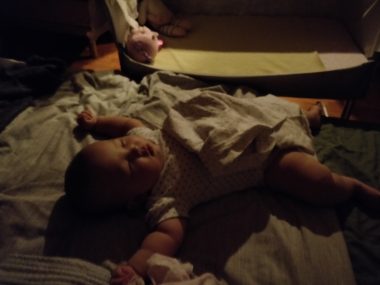How we meet the challenges of routine parenting tasks
For families living with a rare disease, daily life activities can be a struggle
Written by |

During a workshop for rare disease caregivers, a fellow parent reminded me that while therapy and activities are great topics for discussion, we can’t forget the struggle of simply coping with life and completing routine tasks.
Her comment caused me to pause and reflect. It was so true. When I think about it, often our most challenging aspects are the daily, routine tasks, duties that only the parents of a child with a rare disease would understand.
Learning on the job
Autosomal recessive disease: When we first confronted this term, we tried to scan the recesses of our brains for grade-school science class lessons, but we drew a blank. Yet when you ask any seasoned rare disease family, they can explain this term in depth.
When we discovered that our daughter, Rylae-Ann, had aromatic l-amino acid decarboxylase (AADC) deficiency, we learned that both my wife and I were rare recessive carriers of the disease-causing gene mutation. We then had a 25% chance of both passing this recessive gene to our child and her getting the disease.
This anomaly blindsided us. Never did we expect that this would be a possibility. Even after Rylae-Ann was born, it wasn’t until she was 3 months old that we began to suspect something was wrong. We were caught off guard and unprepared for what was ahead.
While we continued our diagnostic journey, we didn’t find much in the way of resources since we were expatriates living in a foreign country. Even after we realized that she had AADC deficiency, we learned there was very little we could do except try to keep our daughter alive.
Over time, as we came to terms with the fact that our daughter had a rare disease, we began to develop a routine. It often felt like it was built on stilts. We’d try a new strategy, find out quickly that it didn’t work, and move on to another, only to learn that the process took time to implement. This back-and-forth search took a team effort from Mom, Dad, and daughter.

Eventually, the Poulin family developed a routine that allowed both daughter and parents to get much-needed rest. (Photo by Richard E. Poulin III)
Caregiver collaboration
The simplest of parenthood tasks was still extremely difficult.
Feeding took an hour easily. We had to work to get Rylae-Ann to sleep, and if we were successful, we couldn’t make the slightest noise for fear of waking her. One of us always had to keep an eye on our daughter while the other completed household chores.
As we reached out to other families in the rare disease community, we learned tips and tricks. Sometimes the tips would work like a charm. Other times we had to tweak them a bit to match our daughter’s needs. Once we had ideas from others, we were more successful with our daily routines.
Sometimes it wasn’t about creating a solution; it was just a moment for parents to share and express the frustrations they experienced at home. There’s no denying the hardship that we’ll undoubtedly be faced with. No tips or tricks are going to grant us a typical lifestyle. That’s why it’s comforting to be able to talk to another caregiver who connects with our struggles.
With time, developing the routine became easier. Communicating with other caregivers provided more ideas and opportunities to decompress.
A caregiver’s lifestyle is unique for each family. The journey won’t be easy, but with thoughtful planning, it becomes easier, opening up more room for memories to be made.

Richard, Judy, and Rylae-Ann learn how to manage symptoms and make memories. (Courtesy of Richard E. Poulin III)
Note: AADC News is strictly a news and information website about the disease. It does not provide medical advice, diagnosis, or treatment. This content is not intended to be a substitute for professional medical advice, diagnosis, or treatment. Always seek the advice of your physician or other qualified health provider with any questions you may have regarding a medical condition. Never disregard professional medical advice or delay in seeking it because of something you have read on this website. The opinions expressed in this column are not those of AADC News or its parent company, Bionews, and are intended to spark discussion about issues pertaining to aromatic l-amino acid decarboxylase deficiency.






Leave a comment
Fill in the required fields to post. Your email address will not be published.